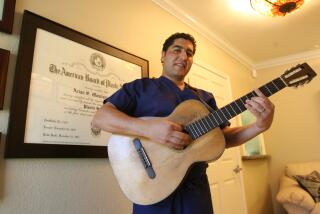About face
Four years ago, Beverly Hills plastic surgeon Brent Moelleken was featured on “Dateline NBC” for his surgical innovation, the superficial cheek lift. The procedure earned him a prize for outstanding contribution to the advancement of aesthetic surgery, publication in a professional journal and not a single new patient.
And yet in the months since Moelleken became a regular on “Extreme Makeover,” patients from around the globe have sought him out, hoping for a miracle. Strangers have stopped him on the street. And his old clients now regard him with a new reverence.
“I’m not a star,” Moelleken says humbly. “I’m just a surgeon. The recognition isn’t the same as if you saw George Clooney.”
Ah, but can George Clooney make you beautiful?
The popularity of reality shows such as “Extreme Makeover,” “The Swan” and “I Want a Famous Face” has redefined the standards of professional success in L.A.’s aesthetic medical community. It’s no longer enough to claim a celebrity clientele or a cutting-edge technique -- today, it takes a TV appearance. A publicist, a press kit and a marketing plan are the newest must-haves. Even those can’t help you, though, if you’re not what one “Extreme Makeover” producer calls “prime-time material.” Forget bedside manner. If you don’t “read well” on camera, you don’t make the cut.
“Before, it was an honored science. It was the respect of a name,” says publicist Kerry Amorim, who represents Beverly Hills cosmetic surgeon Patrick Abergel. “Now it’s like, who can they say they’ve done and how many shows have they been on?”
TV, says Angela O’Mara, whose Newport Beach firm specializes in marketing plastic surgeons, is “where the buck starts.”
Perhaps that’s why it’s become virtually impossible to channel surf without glimpsing a surgeon in blood-stained scrubs, working the business-end of a liposuction wand into the next lucky contestant.
The practice of plastic surgery has become “a dog-and-pony show,” says Beverly Hills plastic surgeon Toby Mayer. Since Mayer was featured on “Extreme Makeover” performing the Fleming/Mayer flap, a hair replacement procedure, he’s fielded offers from other shows. But unlike “Extreme Makeover,” he says, they’re blatantly sensational and often distasteful.
“They say, ‘We’re looking for someone who wants to look like Michelle Pfeiffer, but not the way she looks now, the way she looked 7.5 years ago, and if she had a twin who wanted to look like someone else it would be helpful,’ ” Mayer says. “You wouldn’t believe the calls we get.”
Still, this media swarm hovers over only a select few doctors.
Publicist Heather Burgett spent weeks lobbying “Extreme Makeover” on behalf of Beverly Hills plastic surgeon Steven Varkony, to no avail. After six months of pitching other programs, she finally got a local news crew to film Varkony’s “scarless” arm lift. But the segment was canceled.
“The fact that they shot it validates that it’s a unique procedure,” says Burgett. “However, there’s so much competition for that limited time and space that you never know what is going to take precedence.”
For some patients, a telegenic doctor is a trustworthy one. Jo Wadleigh of Orange County watched surgery shows for months looking for the right doctor to perform her face lift. She eventually narrowed her search to two candidates: Beverly Hills plastic surgeon Jon Perlman from “Extreme Makeover” and Newport Beach plastic surgeon Boris Ackerman from the Discovery Health Channel’s “Plastic Surgery: Before and After.”
In person, Perlman “was everything I thought he was,” says Wadleigh. “He was personal. He was warm. He was caring. He was kind. I felt as though I’d made a friend.” He did her face lift, and Wadleigh has since booked a tummy tuck.
Surgery as entertainment
Plastic surgeons have made the most of self-promotion since the Federal Trade Commission relaxed advertising restrictions on doctors in 1980. Until recently, though, television appearances were limited to occasional segments on local and network news programs. And if the doctor didn’t have a new procedure to demonstrate, he wasn’t newsworthy.
By the late 1990s, surgery shows had proliferated on cable channels such as the E! Entertainment Network, TLC and the Discovery Health Channel. Even then, however, the emphasis was on the doctor’s expertise, not the patient’s self-esteem issues.
It wasn’t until “Extreme Makeover” aired in December 2002 as an ABC special that surgery as entertainment became a clear ratings winner. Of course, more makeover shows followed, among them Fox’s “The Swan,” MTV’s “I Want a Famous Face” and VH1’s “Rock Bodies.”
And, naturally, all this attention on the profession revived old rivalries, particularly among the four organizations that represent plastic and cosmetic surgeons. (Yes, there’s a difference. They’re certified by different boards.)
It started when Dr. James Wells, then president of the American Society of Plastic Surgeons, agreed to endorse “Extreme Makeover.” In return, executive producer Howard Schultz agreed to give the ASPS’ 5,000 members veto power on potential patients, to pay doctors for procedures and to thank the ASPS in the show’s credits.
Schultz also agreed to use only doctors certified by the American Board of Plastic Surgery, thereby disqualifying members of two other organizations: the American Academy of Facial Plastic and Reconstructive Surgery and the American Academy of Cosmetic Surgery.
As news of this agreement spread, so did publicity envy.
The AAFPRS pooh-poohed the show on its website: “A reality show dedicated to giving average people an ‘extreme makeover’ may be a ratings winner, but the AAFPRS suggests a more cautious approach.”
On its website, the AACS faulted the show for “improper conclusions regarding the risks and rewards associated with cosmetic surgery.”
A few months later, the American Society for Aesthetic Plastic Surgery -- whose 1,800 members are also members of the ASPS -- posted a website statement with the headline “Extreme Is ‘Out,’ Subtle ‘In.’ ”
Interestingly, when the producers of “The Swan” came calling, Wells declined to participate. The show “was not in the same format,” he explains. “They’re pitting one patient against another. In essence, they’re pitting one surgeon against another. Almost every other word in terms of describing the situation was that it was a ‘contest.’ ”
In March, the ASPS posted a statement on its website condemning “The Swan” and “I Want a Famous Face” for “creating unhealthy expectations about what plastic surgery can do.”
Ah, but what do healthy expectations have to do with TV?
The ASPS-endorsed “Extreme Makeover” is described on the ABC website as “a real-life fairy tale” in which participants’ “wishes come true, not just to change their looks, but their lives and destinies. This magic is conjured through the skills of an ‘Extreme Team,’ including the nation’s top plastic surgeons....”
“It gets a little bit muddy,” says Dr. Michael Goldrich, chairman of the American Medical Assn.’s Council on Ethical and Judicial Affairs. “We live in a society with an extremely strong belief in autonomy.... There is also a strong belief in one’s 15 minutes of fame.... It sometimes becomes difficult to sort out what’s in the patient’s best interest.”


